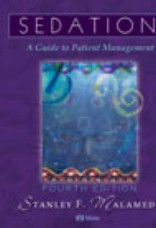|
|
|
| |
 |
|
|

|
 推薦指數:
推薦指數:





|
|
- 內容介紹
|
Sedation, 4th Edition - A Guide to Patient Management
By Stanley F. Malamed, DDS
Over 605 pp, Over 465 ills, Copyright 2003
Mosby Title
ISBN:0323012264
Description
This definitive, authoritative clinical manual stands alone in the field of patient sedation. Combining essential theory with technical instruction, it presents "everything in a nutshell" for the practicing professional and student of dentistry. Key factors such as the physical, emotional, and mental condition of the patient – as well as required ADA guidelines – are incorporated into sedation techniques designed to improve the patient's overall dental experience. The result is an indispensable book, expert in its professional protocols and techniques, and comprehensive in its wide-ranging considerations. Detailed chapters, divided into eight parts, are devoted to topics on: the problem of fear and anxiety in dentistry; pain and anxiety control; pharmacosedation; history and techniques of general anesthesia; inhalation and intravenous sedation, preparation and management of emergencies in the dental office; and sedation for special needs patients – pediatric, geriatric, and medical and physically compromised patients.
Spanish version of 3rd edition also available, ISBN: 84-8174-136-1
Key Features
Written by an acknowledged expert in the field, the book draws on a wealth of clinical experience and ability.
Combines all aspects of sedation with essential theoretical and technical instruction.
Techniques are divided into sections on pharmacology, armamentarium, and technique and complications – described in explicit detail that allows it to be used as a chairside reference.
Pharmacosedation is covered in full, with discussions of oral, rectal, and IM premedication, as well as nine chapters on inhalation sedation and ten chapters on IV sedation.
Covers all of the components required by the ADA guidelines: review of cardiovascular and respiratory physiology; selection of agents; techniques of administration; and management of complications and emergencies.
Step-by-step descriptions of inhalation sedation (nitrous oxide and oxygen) and intravenous sedation provide a superb clinical "picture" of the procedures.
Chapters on pediatric, geriatric and physically and medically compromised patients offer valuable, up-to-date information on the management of these special needs patients.
In-depth discussions of the pharmacology of commonly used sedative agents allow the reader to fully understand properties and characteristics of drugs used.
New to this Edition
Content has been completely updated to include the most current drug dosage information.
More information on recreational abuse of nitrous oxide reflects the current societal trends.
The latest American Heart Association recommendations help prevent bacterial endocarditis.
Increased emphasis on nitrous oxide/oxygen, as many dental hygienists are becoming certified to administer this form of sedation.
New contributors lend credibility and experience to each topic discussed.
Content outlines at the beginning of each chapter allow for quick reference of specific topics.
Improved illustrations and photographs offer a fresh look, with high-quality art to aid in the visualization of techniques and procedures.
Table of Contents
Part One: Introduction 1. Pain and Anxiety in Dentistry Part Two: Spectrum of Pain and Anxiety Control 2. Introduction to Conscious Sedation 3. The Spectrum of Pain and Anxiety Control 4. Physical and Psychological Evaluation 5. Monitoring During Conscious Sedation 6. Non-Drug Techniques: Iatrosedation and Hypnosis Part Three: Oral, Rectal, and Intramuscular Sedation 7. Oral Sedation 8. Rectal Sedation 9. Sublingual, Transdermal, and Intranasal Sedation 10. Intramuscular Sedation Part Four: Inhalation Sedation 11. Historical Perspective 12. Pharmacosedation: Rationale 13. Pharmacology, Anatomy, and Physiology 14. Armamentarium 15. Inhalation Sedation: Techniques of Adminstration 16. Inhalation Sedation: Complications 17. Contemporary Issues Surrounding Nitrous Oxide 18. Practical Considerations 19. Teaching Inhalation Sedation: History and Present Guidelines Part Five: Intravenous Sedation 20. Historical Perspective 21. Intravenous Conscious Sedation: Rationale 22. Armamentarium 23. Anatomy for Venipuncture 24. Venipuncture Technique 25. Pharmacology 26. Techniques of Intravenous Conscious Sedation 27. Complications 28. Practical Considerations 29. Guidelines for Teaching Part Six: General Anesthesia 30. Background 31. Armamentarium, Drugs, and Techniques Part Seven: Emergency Preparation and Management 32. Preparation for Emergencies 33. Emergency Drugs and Equipment 34. Management of Emergencies Part Eight: Special Considerations 35. The Pediatric Patient 36. The Geriatric Patient 37. The Medically Compromised Patient 38. The Physically Compromised Patient 39. Neurologic Illnesses and Other Conditions
Author Information
By Stanley F. Malamed, DDS, Professor and Chair, Section of Anesthesia and Medicine, University of Southern California School of Dentistry, Los Angeles, CA
|
|
|

